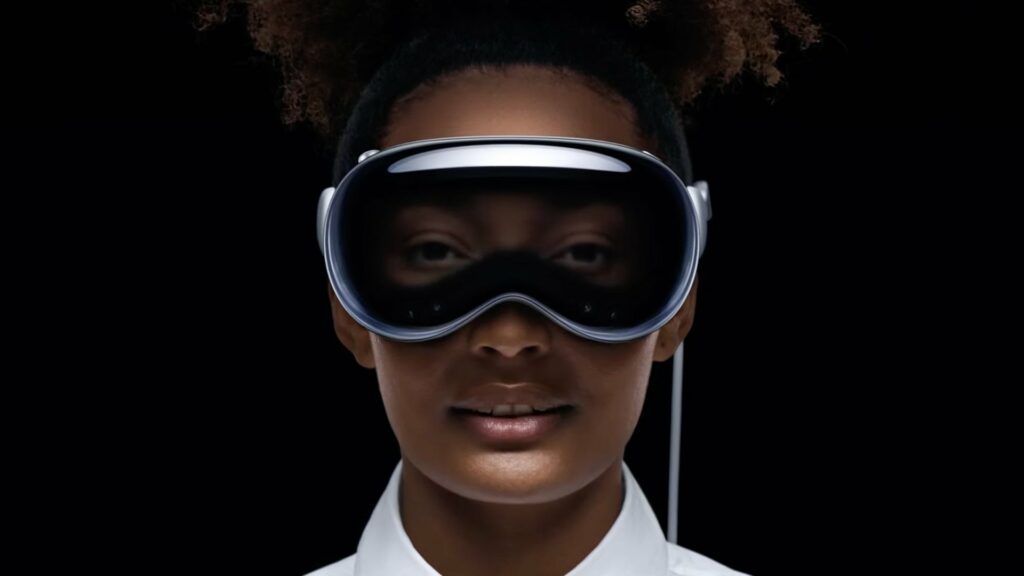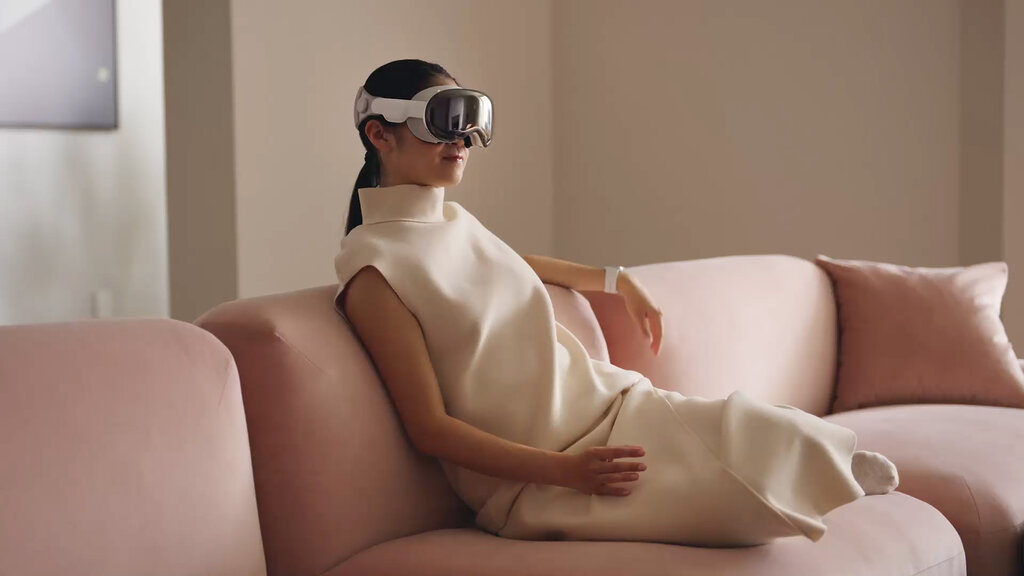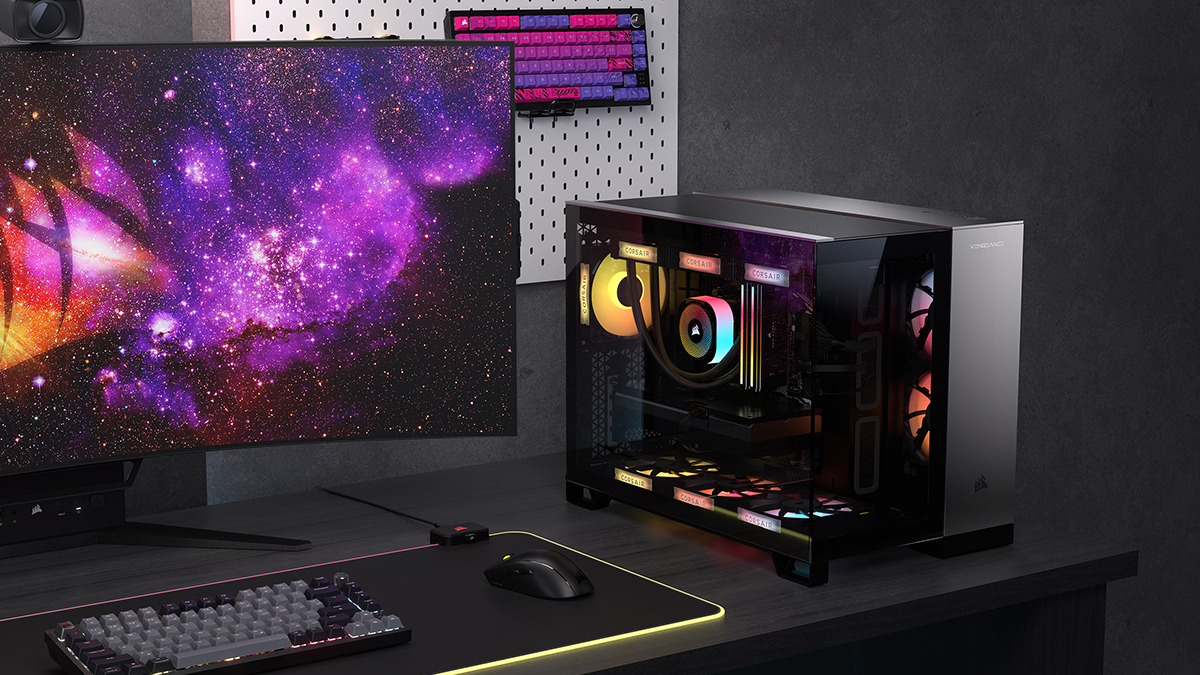- The Apple Vision Pro seeks to change how audiences interact with content.
- It features various modes, including VR, AR, MR, and XR.
- The headset features two micro-OLED screens with a 90Hz refresh rate.
- Apple has also featured the M2 and R1 chips to power the Vision Pro.
- The headset can be bought for $3,499.
The Apple Vision Pro is dubbed the company’s most important launch in 2024, following more than a decade of research and development in augmented and virtual reality. Nine years after the Apple Watch, this product adds a new category to the company’s portfolio.
Using information converted through cameras into a digital image, the Vision Pro aims for complete immersion, absorbing users in its virtual environment. These cameras are also switched off in VR mode to add to this immersion.
This mode completely replaces your field of view with content from the headset. Meanwhile, AR mode presents a mix of information from the headset and the real world, using the environment as an overlay for digital content.
Apple also offers MR mode, which combines both VR and AR. Finally, XR, or Extended Reality, combines all three for another unique experience.

Design and Internals
Apple’s first headset goes for a very distinct design, looking similar to ski goggles. In addition to an aluminum frame, the headset employs a single piece of laminated glass for the front.
It also includes two micro-OLED screens on the inside, offering a 90Hz refresh rate and over 4K resolution to each eye. Apple’s popular M2 processor from devices like the Macbook and iPad is the heart of the Vision Pro’s procession power.
While the new R1 chip handles inputs from the cameras, sensors, and microphones, the M2 chip deals with visionOS, algorithms, and the visuals shown on-screen. These internals are powered by an external battery or an adaptor since no batteries are included in the headset.
Still, the battery pack can provide up to 2.5 hours of battery.

Spatial Audio & Comfort
With two Audio Straps and built-in speakers, Apple Vision Pro offers Spatial Audio. It can combine the headset and real-world audio, creating a completely new experience.
Connected to these straps is a 3D knitted headband. It holds the headset in place and adds to the comfort of the device, thanks to a breathable and elastic material. Furthermore, a Fit Dial ensures the headset fits well on the head.
The focus on comfort extends to other parts of the Apple Vision Pro’s build as well. With weight equally distributed across the top and bottom, a dual-strap construction ensures users can wear the headset for long sessions.
No Controllers Allowed
Apple has decided against controllers for the Vision Pro, instead relying on hand gestures and commands for basic tasks. Highlighting an application is as easy as glancing at it, while taps can be used to select any highlighted applications.
Furthermore, scrolling is intuitive and can be carried out with a flick of the fingers.

FaceTime Is Better With Vision Pro & Its Cameras
When using this headset, several camera and sensor maps work on mapping out surroundings and monitoring your hand gestures. Optic ID is used for verification, relying on infrared lights and cameras to scan the iris.
This feature effectively serves as the Vision Pro’s version of Face ID. It can be used in place of passwords, for device unlocking, and to make purchases. However, these cameras also serve to enhance FaceTime.
Using the Apple Vision Pro, calls and meetings are more immersive than before. When using FaceTime, the headset portrays call attendants through huge tiles, while the user shows up as a digital reconstruction for everyone else.
FaceTime can also be used to share apps and work through the Vision Pro. Spacial Audio further adds to this experience, leading to clear audio and communication during calls.

Release Date & Price
Apple has officially confirmed the Vision Pro will arrive on 2nd February. Following the initial announcement, pre-orders for the headset began on 19th January in the US, giving curious buyers plenty of time to pre-purchase before the launch.
The headset is priced at $3,499 with 256GB storage, and it can be ordered online and in-store. Additional accessories like the Zeiss Optical Inserts cost $99, while the Zeiss Prescription Optical Inserts cost $149.
However, the current launch is limited to the United States. According to Bloomberg, other parts of the world, like Canada and the UK, should see a launch soon after the United States.
However, other European countries and Asia might not receive the Apple Vision Pro until 2025.
Repairs Are Expensive Without AppleCare
Repairs, depending on the scenario, can cost up to 70% of the headset’s initial price. A cracked cover glass will require up to $799 for repairs, but damaging the unit itself will set buyers back $2,399.
This should be enough to encourage buyers of the Apple Vision Pro to consider AppleCare Plus. Cutting the cost to just $300 from $2,399, insurance is practically mandatory for anybody considering this headset.
Thank you! Please share your positive feedback. 🔋
How could we improve this post? Please Help us. 😔
[Editor-in-Chief]
Sajjad Hussain is the Founder and Editor-in-Chief of Tech4Gamers.com. Apart from the Tech and Gaming scene, Sajjad is a Seasonal banker who has delivered multi-million dollar projects as an IT Project Manager and works as a freelancer to provide professional services to corporate giants and emerging startups in the IT space.
Majored in Computer Science
13+ years of Experience as a PC Hardware Reviewer.
8+ years of Experience as an IT Project Manager in the Corporate Sector.
Certified in Google IT Support Specialization.
Admin of PPG, the largest local Community of gamers with 130k+ members.
Sajjad is a passionate and knowledgeable individual with many skills and experience in the tech industry and the gaming community. He is committed to providing honest, in-depth product reviews and analysis and building and maintaining a strong gaming community.


 Threads
Threads

